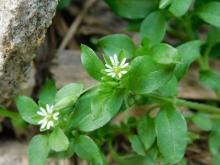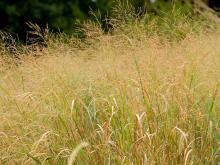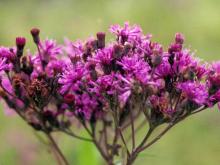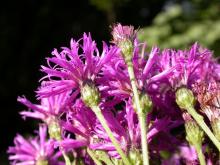Wildflowers, Grasses and Other Nonwoody Plants
Media

Species Types
Scientific Name
Persicaria virginiana (formerly Polygonum virginianum)
Description
Virginia knotweed, or jumpseed, is common yet rarely contemplated. It might be most eye-catching in spring, when its new, oval leaves are marked with brownish Vs. In summer, it blooms with tiny, teardrop-shaped white flowers on wandlike stems.
Media

Species Types
Scientific Name
Symphyotrichum spp. (formerly Aster spp.)
Description
Missouri has 24 species of New World asters in genus Symphyotrichum. Most have purple or white ray flowers and yellow disk flowers that turn reddish over time. Most bloom in late summer and fall.
Media

Species Types
Scientific Name
Cuscuta spp.
Description
Dodders are easy to identify, even though at first you might not recognize them as plants. These parasitic plants usually look like a hairlike mass of yellow or orange, leafless, wiry, vining stems wrapping around the stems of other plants.
Media

Species Types
Scientific Name
Viola spp.
Description
Violets, as a group, are fairly easy to identify, with their colorful five-petaled “faces” so welcome in springtime. Missouri has 17 species, and some are confusingly similar. This page introduces them as a group.
Media

Species Types
Scientific Name
Viola striata
Description
Pale violet, or cream violet, is Missouri’s only white-flowering violet that produces true aboveground stems. It is scattered to common in the Ozarks, Ozark border, and Bootheel lowlands and uncommon or absent elsewhere in the state.
Media

Species Types
Scientific Name
Stellaria media
Description
Common chickweed, native to Europe, has been introduced nearly worldwide and is a familiar garden weed in Missouri. It forms spreading mats on the ground and has small flowers with 5 petals, each deeply lobed making it look like 10.
Media

Species Types
Scientific Name
Panicum virgatum
Description
Switchgrass is a native perennial, warm-season, clump-forming mid or tall grass. In midsummer, delicate-looking, open, multiply-branching flowering clusters rise above the foliage.
Media

Species Types
Scientific Name
Vernonia missurica
Description
Missouri ironweed is one of Missouri’s five species of ironweeds. Most common in the eastern half of the state, it is a hairy ironweed with a relatively large number of florets per flowerhead.
Media

Species Types
Scientific Name
Vernonia spp.
Description
Five species of ironweeds live in Missouri. Starting in the middle of summer, they bear showy clusters of magenta or purple flowerheads at the branching tops of upright stalks.
Media

Species Types
Scientific Name
Vernonia gigantea (formerly V. altissima)
Description
Tall ironweed is one of Missouri’s five species of ironweeds. Most common in southeast Missouri but scattered statewide, it can grow up to 10 feet tall. To verify an ID, note leaf and flowerhead characters.
See Also
About Wildflowers, Grasses and Other Nonwoody Plants in Missouri
A very simple way of thinking about the green world is to divide the vascular plants into two groups: woody and nonwoody (or herbaceous). But this is an artificial division; many plant families include some species that are woody and some that are not. The diversity of nonwoody vascular plants is staggering! Think of all the ferns, grasses, sedges, lilies, peas, sunflowers, nightshades, milkweeds, mustards, mints, and mallows — weeds and wildflowers — and many more!





















